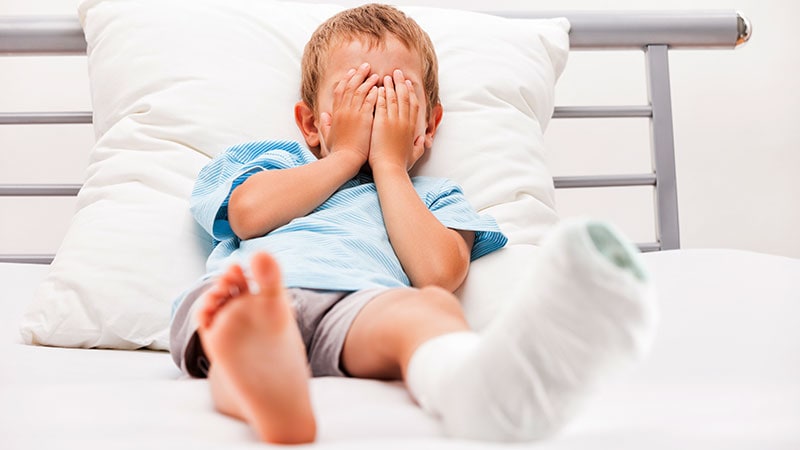Canada has published the first-ever national standard to guide pediatric pain management in children’s, community or regional, and rehabilitation hospitals that treat children up to age 19.
Development of the standard, which is a global first, followed “a rigorous accredited process that’s put forward by the Standards Council of Canada” and includes a literature review, a working group of pediatric pain experts, hospital administration and policy development experts, and people with lived experience, Kathryn Birnie, PhD, assistant professor of anesthesiology, perioperative, and pain medicine at the University of Calgary, Calgary, Alberta, Canada, told Medscape Medical News. Birnie led the working group that developed the standard.

Kathryn Birnie, PhD
“Unlike a guideline, which focuses on clinical practice, the standard also provides guidance to organizational leaders about what needs to happen systemically in an organization to achieve quality, equitable pain management for children,” Birnie added.
“This means things like, for example, having a dedicated pain committee to ensure that there are hospital-wide policies prioritizing children’s pain, and a pain assessment that’s not just about how intense pain is, but also includes psychosocial aspects, such as mood, sleep, school functioning, and cultural factors that may affect a child’s pain experience.”
The standard was drafted by Solutions for Kids in Pain (SKIP), a nonprofit organization, and Canada’s Health Standards Organization. It was published online April 3.
Pediatric Pain Minimized
The standard takes the following four goals laid out by the 2021 Lancet Child & Adolescent Health Commission as its foundation: to make pain matter, to make pain understood, to make pain visible, and to make pain better.
To achieve these goals, the standard offers 34 recommendations. They relate to tasks such as establishing a pediatric pain management framework, promoting professional development, carrying out comprehensive pain assessment and reassessment, and codeveloping individualized care plans and multimodal pain management strategies.
In addition, the standard emphasizes “how to deliver equitable, evidence-informed, and person-centered pain care and supports,” according to the working group. “It recognizes that children and families are equal members of the health team, actively involved in discussions and decision-making about their pain care.”
Furthermore, the standard includes a tenet that is “quite new in how we conceptualize pain in hospitals,” said Birnie. “We set out criteria that pinpoint preventable pain or poorly managed pain as a patient safety issue. That means there’s accountability for reporting these incidents and following up to make sure they don’t happen again.”
Pain in children often is minimized, she continued. “People say things like, ‘It’s just a needle procedure. I didn’t have help with that when I was a kid.’ But we now have scientific evidence that there are short- and long-term consequences to poorly managed painful procedures that affect babies and teens and may lead them to become adults with chronic pain, at increased risk for mental health issues, socioeconomic disparities, and substance use.”

Dr Fiona Campbell
“In effect, this standard shifts the responsibility from clinicians to organizations to provide the framework and culture for the workforce to have the knowledge, skill, and judgment to prevent and treat children’s pain effectively,” Fiona Campbell, MD, a professor of anesthesia at the University of Toronto, Toronto, Ontario, Canada, and medical director of the Chronic Pain Program at the Hospital for Sick Children, told Medscape.
Campbell also is codirector of the SickKids Pain Centre, a SKIP hub lead, and former president of the Canadian Pain Society. She was codirector of the Canadian Pain Task Force when it was charged with creating a national pain action plan.
“People don’t realize how common pain continues to be in hospitalized children, that it’s often moderate or severe, that it’s undertreated, and it costs the economy billions of dollars a year,” she said. “I think the nonexperts in healthcare settings in particular would be surprised if they knew more about pain in hospitals and chronic pain in children.”
‘Do the Right Thing’
“Our focus really is to support equitable pain management as a part of quality pain management, as many children from equity-seeking groups are disproportionately impacted by pain,” said Birnie. “They are at greater risk for experiencing it but unfortunately also are less likely to get care for it. This is something we should have already been doing and it’s something that all children deserve.”
“It pulls at the heartstrings to think of children in pain,” said Campbell. “They’re a very vulnerable group, and I think this standard will get legs because people want to do the right thing.
“Pain is often a byproduct of why kids are in hospital, in the sense that they come in to have surgery or a disease diagnosed and treated, and pain happens to them as a result. It’s not necessarily a priority for clinicians and organizations,” she said.
“They should view the standard as an opportunity to create awareness and get people ready to implement some of the things in it that really work, including not just pharmacological strategies, but also physical strategies such as ice and heat and psychological strategies such as meditation and relaxation,” Campbell concluded.
Pediatric Pain Management. Published online April 3, 2023. Abstract.
Birnie and Campbell reported no relevant financial relationships.
Follow Marilynn Larkin on Twitter: @MarilynnL.
For more news, follow Medscape on Facebook, Twitter, Instagram, and YouTube.
Source: Read Full Article
